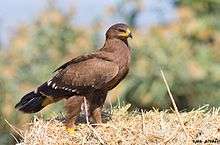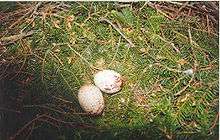Lesser spotted eagle
| Lesser spotted eagle | |
|---|---|
 | |
| Adult Note light patches on wings and white V on rump | |
| Scientific classification | |
| Kingdom: | Animalia |
| Phylum: | Chordata |
| Class: | Aves |
| Order: | Accipitriformes |
| Family: | Accipitridae |
| Subfamily: | Buteoninae (disputed) |
| Genus: | Clanga |
| Species: | C. pomarina |
| Binomial name | |
| Clanga pomarina Brehm, 1831 | |
| | |
| Range of C. pomarina Breeding range Resident range Wintering range | |
| Synonyms | |
|
Aquila pomarina | |
The lesser spotted eagle (Clanga pomarina) is a large Eastern European bird of prey. Like all typical eagles, it belongs to the family Accipitridae. The typical eagles are often united with the buteos, sea eagles, and other more heavy-set Accipitridae, but more recently it appears as if they are less distinct from the more slender accipitrine hawks than believed.
Description
This is a medium-sized eagle, about 60 cm (24 in) in length and with a wingspan of 150 cm (59 in). Its head and wing coverts are pale brown and contrast with the generally dark plumage. The head and bill are small for an eagle. Usually, a white patch occurs on the upper wings, and even adults retain a clearly marked white "V" on the rump; the wing markings are absent and the white "V" is not well-defined in the greater spotted eagle.
The juvenile has less contrast in the wings, but the remiges bear prominent white spots. It differs from greater spotted eagle juveniles by a lack of wing covert spotting and the presence of a cream-colored neck patch.
The call is a dog-like yip.
Systematics, taxonomy and evolution
The birds formerly considered to be the resident Indian subspecies are now considered a separate species, the Indian spotted eagle (Clanga hastata), quite distinct and readily separable by morphological, behavioral, ecological, and DNA sequence data. The European taxon is actually closer to the greater spotted eagle; their common ancestor seems to have diverged around the middle Pliocene, perhaps some 3.6 million years ago,[2] from the ancestors of the Indian birds. The "proto-spotted eagle" probably lived in the general region of Afghanistan, being split into a northern and a southern lineage when both glaciers and deserts advanced in Central Asia as the last ice age began. The northern lineage subsequently separated into the eastern (greater) and western (lesser) species of today, probably around the Pliocene-Pleistocene boundary not quite 2 million years ago.[3][4][5]
The spotted eagles as a group are quite distinct from the typical members of Aquila, the "true eagles".

The present species hybridizes occasionally with the greater spotted eagle. Hybrid birds are almost impossible to identify if not seen up close.[6]
Distribution and ecology
The lesser spotted eagle breeds in Central and Eastern Europe and southeastward to Turkey, and winters in Africa. This is a very wary species of open or lightly wooded country, in which it hunts small mammals and similar terrestrial prey. This eagle lays one to three white, buff-spotted eggs in a tree nest. As usual for eagles, only in breeding seasons with very abundant prey does more than one young fledge, but the female starts incubating when the first egg has been laid, thus the first young to hatch usually outgrows its clutch mate(s) and will kill and even eat them sooner or later.
References
- ↑ BirdLife International (2013). "Clanga pomarina". IUCN Red List of Threatened Species. Version 2013.2. International Union for Conservation of Nature. Retrieved 26 November 2013.
- ↑ The estimate in Väli 2006 is certainly incorrect; it uses a molecular clock that is appropriate for small passerines with half the generation times of eagles.
- ↑ Parry, S.J.; Clark, W.S.; Prakash, V. (2002). "On the taxonomic status of the Indian Spotted Eagle Aquila hastata". Ibis. 144 (4): 665–675. doi:10.1046/j.1474-919X.2002.00109.x.
- ↑ Rasmussen, Pamela C.; Anderton, John C. (2005). Birds of South Asia - The Ripley Guide. Barcelona: Lynx Edicions. ISBN 84-87334-67-9.
- ↑ Väli, Ülo (2006). "Mitochondrial DNA sequences support species status for the Indian Spotted Eagle Aquila hastata" (PDF). Bulletin of the British Ornithologists' Club. 126 (3): 238–242.
- ↑ Väli, Ülo; Lõhmus, Asko (2004). "Nestling characteristics and identification of the lesser spotted eagle Aquila pomarina, greater spotted eagle A. clanga, and their hybrids". Journal of Ornithology. 145 (3): 256–263. doi:10.1007/s10336-004-0028-7.
Further reading
- Svensson, Lars (1–8 November 1986). Underwing pattern of Steppe, Spotted and Lesser Spotted Eagles. International Bird Identification: Proceeedings of the 4th International Identification Meeting. Eilat: International Birdwatching Centre Eilat. pp. 12–14.
External links
| Wikimedia Commons has media related to Aquila pomarina. |
| Wikispecies has information related to: Aquila pomarina |
- Lesser spotted eagle species text in The Atlas of Southern African Birds
- BirdLife species factsheet for Aquila pomarina
- "Aquila pomarina". Avibase.

- "Lesser spotted eagle media". Internet Bird Collection.
- Lesser spotted eagle photo gallery at VIREO (Drexel University)
- Audio recordings of Lesser Spotted Eagle on Xeno-canto.
